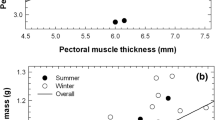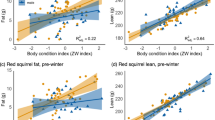Abstract
We used non-invasive ultrasonography to investigate seasonal changes in liver size of an obligate hibernator; the edible dormouse (Glis glis). We repeatedly measured liver size in dormice at two study sites, (1) an enclosure-housed colony and (2) a free-ranging population. We observed a significant increase in transverse liver size throughout the active season; however, this effect was most pronounced in animals with low body mass early in the active season. Ultrasonography imaging revealed that the content of fat in the liver (distributed in an unexpected pattern of discrete focal areas) visibly increased at the end of the active season both in the field and enclosure. Thus, the observed increase in liver size of dormice seems mainly related to fat accumulation. We found no principal differences in the time courses of transversal liver size between the two study sites. Our results support the view that non-invasive ultrasonography is an accurate method to study internal organ sizes, such as liver, in the laboratory and in the field.



Similar content being viewed by others
References
Barr F (1990) Diagnostic Ultrasound in the Dog and Cat. Blackwell Scientific Publications, Oxford
Bieber C, Ruf T (2009) Summer dormancy in edible dormice (Glis glis) without energetic constraints. Naturwissenschaften 96:165–171
Carey HV (1990) Seasonal changes in mucosa structure and function in ground quirrel intestine. Am J Phsiol 259:R385–R392
Carey HV, Cook HJ (1991) Effect of hibernation and jejunal bypass on mucosal structure and function. Am J Physiol 261:G37–G44
Dietz MW, Dekinga A, Piersma T, Verhulst S (1999) Estimating organ size in small migrating shorebirds with ultrasonography: An intercalibration exercise. Physiol Biochem Zool 72:28–37
Dykstra CP, Karasov WH (1992) Changes in gut structure and function of house wrens (Troglodytes aedon) in response to increased energy demands. Physiol Zool 65:422–442
Fell BFM, Smith KA, Campbell RM (1962) Hypertrophic and hyperplastic changes in the alimentary canal of the lactating rat. J Pathol Bacterial 85:179–188
Fietz J, Pflug M, Schlund W, Tataruch F (2005) Influences of the feeding ecology on body mass and possible implications for reproduction in the edible dormous (Glis glis). J Comp Physiol B 175:45–55
Geiser F, Ruf T (1995) Hibernation versus daily torpor in mammals and birds: physiological variables and classification of torpor patterns. Physiol Zool 68:935–966
Hammond KA, Diamond J (1994) Limits to dietary nutrient uptake and intestinal nutrient uptake in lactating mice. Physiol Zool 67:282–303
Hammond KA, Diamond J (1997) Maximal sustained energy budgets in humans and animals. Nature 386:457–462
Hammond KA, Kristan DM (2000) Responses to lactation and cold exposure by deer mice (Peromyscus maniculatus). Physiol Biochem Zool 73:547–556
Hume ID, Biebach H (1996) Digestive tract function in the long-distance migratory garden warbler, Sylvia borin. J Comp Physiol B 166:388–395
Hume ID, Beiglböck C, Ruf T, Frey-Roos F, Bruns U, Arnold W (2002) Seasonal changes in morphology and function of the gastrointestinal tract of free-living alpine marmots (Marmota marmota). J Comp Physiol B 172:197–207
Konarzewski M, Starck JM (2000) Effects of food shortage and oversupply on energy utilization, histology, and function of gut in nestling song thrushes (Turdus philomelos). Physiol Biochem Zool 73:416–427
Kryštufek B (2001) Compartmentalization of body of a fat dormouse. Trakya Univ J Sci Res B 2:95–106
Malatesta M, Zancanaro C, Baldelli B, Gazzanelli G (2002) Quantitative ultrastructural changes of hepatocyte constituents in euthermic, hibernating and arousing dormice (Muscardinus avellanarius). Tissue Cell 34:397–405
Mrosovsky N (1990) Rheostasis: The Physiology of Change. Oxford University Press, New York
Nyland TG, Mattoon JS, Wisner ER (1995) Ultrasonography of the liver. In: Nyland TG, Mattoon JS (eds) Veterinary Diagnostic Ultrasound. WB Sounders Company, Philadelphia, USA, pp 52–73
Penninck DG (1995) Imaging artifacts in ultrasound. In: Nyland TG, Mattoon JS (eds) Veterinary diagnostic ultrasound. Saunders, Philadelphia, pp 19–29
Piersma T, Lindström Å (1997) Rapid reversible changes in organ size as a component of adaptive behaviour. Trends Ecol Evol 12:134–138
Piersma T, Bruinzeel L, Drent R, Kersten M, Van der Meer J, Wiersma P (1996) Variability in basal metabolic rate of a long-distance migrant shorebird (red knot, Calidris canutus) reflects shifts in organ size. Physiol Zool 69:191–217
Pinheiro J, Bates D, DebRoy S, Sarkar D, R Core team (2008) nlme: Linear and nonlinear mixed effects models. R package version 3.1-90.
R Development Core Team (2008) R: A language and environment for statistical computing. R Foundation for Statistical Computing, Vienna, Austria. ISBN 3-900051-07-0, URL http://www.R-project.org.
Redrobe S (2001) Immaging techniques in small mammals. Semin Avian Exot Pet Med 10:187–197
Sailer MM, Fietz J (2009) Seasonal differences in the feeding ecology and behavior of male dormice (Glis glis) Mamm Biol 74:114–124
Secor SM, Diamond J (1997) Effects of meal size on postprandial responses in juvenile Burmese pythons (Python molurus). Am J Physiol 272:R902–R912
Secor SM, Diamond J (1998) A vertebrate model of extreme physiological regulation. Nature 395:659–662
Secor SM, Stein ED, Diamond J (1994) Rapid upregulation of snake intestine in response to feeding: a new model of intestinal adaptation. Am J Physiol 266:G695–G705
Speakman JR, McQueenie J (1996) Limits to sustained metabolic rate: the link between food intake, basal metabolic rate, and morphology in reproducing mice, Mus musculus. Physiol Zool 69:746–769
Starck JM (2003) Shaping up: how vertebrates adjust their digestive system to changing environmental conditions. Anim Biol 53:245–257
Starck JM, Beese K (2001) Structural flexibility of small intestine and liver of garter snakes in response to feeding and fasting. J Exp Biol 205:1377–1388
Starck JM, Cruz-Neto AP, Abe AS (2007) Physiological and morphological responses to feeding in broad-nosed caiman (Caiman latirostris). J Exp Biol 210:2033–2045
Strijkstra AM (1999) Periodic euthermy during hibernation in the European ground squirrel: causes and consequences. Ph.D. Thesis, Rijksuniversitait Groningen, Netherlands.
Vietinghoff-Riesch A, Frhr v (1960) Der Siebenschläfer (Glis glis L.). Monographien der Wildsäugetiere XIV, Jena (in German).
Wahaj SA, Place NJ, Weldele ML, Glickman SE, Holekamp KE (2007) Siblicide in the spotted hyena: analysis with ultrasonic examination of wild and captive animals. Behav Ecol 18:974–984
Wang LCH (1978) Energetics and field aspects of mammalian torpor: the Richardson's ground squirrel. In: Wang LCH, Hudson JW (eds) Strategies in Cold: Natural Torpidity and Thermogenesis. Academic Press, New York, pp 109–145
Weiner J (1992) Physiological limits to sustainable energy budgets in birds and mammals: ecological implications. TREE 7:384–388
Acknowledgements
This study was supported by the City of Vienna and the province of Lower Austria. We thank P. Steiger for taking care of the enclosure-housed dormice colony. We thank K. Hittmair for support in the interpretation of the ultrasonographic imaging and R. Drury for helpful comments on the manuscript. We declare that the here presented study complies with protocols approved by the animal care committee of the Veterinary University Vienna, Austria and adhered to the legal requirements of the country Austria, where the study was conducted.
Author information
Authors and Affiliations
Corresponding author
Additional information
Communicated by C. Gortázar
Rights and permissions
About this article
Cite this article
Bieber, C., Außerlechner, K., Skerget, C. et al. Seasonal changes in liver size in edible dormice (Glis glis): non-invasive measurements using ultrasonography. Eur J Wildl Res 57, 657–662 (2011). https://doi.org/10.1007/s10344-010-0476-8
Received:
Revised:
Accepted:
Published:
Issue Date:
DOI: https://doi.org/10.1007/s10344-010-0476-8




